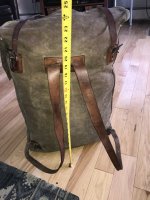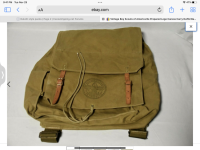Huh? What are the 'ears'?don’t forget the ears.
-
Happy Birthday, Yul Brynner (1920-85)! 👑➕ℹ️
You are using an out of date browser. It may not display this or other websites correctly.
You should upgrade or use an alternative browser.
You should upgrade or use an alternative browser.
Duluth style packs
- Thread starter Patrick Corry
- Start date
I think the side panels in the box style are the way to go.I think I would add 4" side panels to make the main compartment rectangular rather than envelope shape.
Frost River packs use 18oz waxed canvas. I don’t use liners but instead use dry bags which helps keep things organized. The waxed canvas has never gotten wet inside even in multi day rain and bilge water. It could be a pain to sew, and if you used a lighter canvas you could easily wax it after it was constucted.
Barry
The ears are the little flaps with a grommet , located at the top of the side panels, that the girl in the video used to secure the top. Most times I don't worry about that and use them as grab handles. Mo betta.
I don't have a pack to measure but I think the side panels on my #4 Duluth are 6"
I don't have a pack to measure but I think the side panels on my #4 Duluth are 6"
Ah... I thought of them as compression flaps, but yeah, they would work as side grips. They are in my thinking.
I was thinking that 4" panels would be enough judging by the volume of the existing envelope style pack I experimented with. As you said, I'll have to experiment with the width of the pack. In order to stow as far forward as possible for trim weight in the canoe, I may make the pack narrower, maybe 24", in which case I might increase the side panels to 6" to compensate. I may make a few sample bags from old bedsheets to experiment with final shapes.
I was thinking that 4" panels would be enough judging by the volume of the existing envelope style pack I experimented with. As you said, I'll have to experiment with the width of the pack. In order to stow as far forward as possible for trim weight in the canoe, I may make the pack narrower, maybe 24", in which case I might increase the side panels to 6" to compensate. I may make a few sample bags from old bedsheets to experiment with final shapes.
I'd put in rectangular side panels, ears on top of the side panels, and a pocket on each side panel. I'll measure the width of the side panels on my Duluth Combo Cruiser if I have a chance this weekend.
Here’s some pictures and measurements of the Woods Pack I received from Chip. This packs first life was spent with an outfitter on the Albany River in northern Ontario. It’s lighter canvass than a Duluth Pack Wanderer, but it has held up well, just a few pin holes on the bottom and two small sewing repairs.
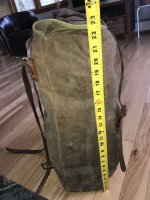
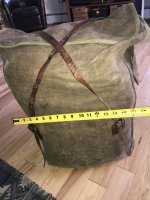
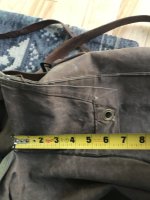
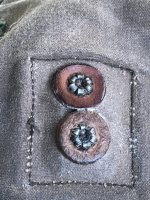






Attachments
Thanks Robin. There are a couple of details I like on your pictured pack; the binding around the top flap and bag rim, the crossover leather straps, and the fact that the 'ears', or compression flaps end in a tapered manner with one grommet. The Duluth flaps seem to have two grommets on each flap which are going to get gathered to one point anyway when the drawstring is closed, so what's the point of having two?
Further, I had been imagining what it would look like to topstitch the side seams, after the initial flat seam, for additional strength and to define better the side panels. Your Woods pack has this feature. I think it's a good idea and may be stronger.
In order to approximate the 70 liters which I am accustomed to with my Sealline dry pack, I would need to make the bag 27"x27"x6" for a volume of 68.34 liters. While looking on the Duluth site, I noticed that their pictures of the Monarch #4 pack (79 liters) which has a depth of 9" causes more weight to be carried farther away from the wearer's back. In my backpacking experience, the closer the load is to the wearer's back, the easier to carry. Of course, adding a tump will help mitigate this effect.
I know... this is a lot of thinking about a topic that should be pretty simple, but the mental exercise appeals to me. Besides, it's too cold out in my barn to actually work on my current w/c canoe restoration, so I need a winter project indoors!
Further, I had been imagining what it would look like to topstitch the side seams, after the initial flat seam, for additional strength and to define better the side panels. Your Woods pack has this feature. I think it's a good idea and may be stronger.
In order to approximate the 70 liters which I am accustomed to with my Sealline dry pack, I would need to make the bag 27"x27"x6" for a volume of 68.34 liters. While looking on the Duluth site, I noticed that their pictures of the Monarch #4 pack (79 liters) which has a depth of 9" causes more weight to be carried farther away from the wearer's back. In my backpacking experience, the closer the load is to the wearer's back, the easier to carry. Of course, adding a tump will help mitigate this effect.
I know... this is a lot of thinking about a topic that should be pretty simple, but the mental exercise appeals to me. Besides, it's too cold out in my barn to actually work on my current w/c canoe restoration, so I need a winter project indoors!
I saw Duluth Pack on Fox and Friends this morning. Fox was featuring “Made in America” products. The only pack they had on display was a DP Day Pack, still nice to see imo.
- Joined
- Jan 7, 2016
- Messages
- 940
- Reaction score
- 874
Nice to see Robin’s Woods Pack ready for a trip, stuffed to the rim. I noticed he is using the compression flaps for their intended purpose. I think of these flaps as extra protection from rain and an extra barrier to keep gear in the pack. I have seen hundreds of #4 packs on portage trails in the BWCA, the Quetico county Northwest of Lake Superior. Thousands of pictures of them too, never have once seen them hanging outside the pack, to be used to lift the pack. Never heard them called ears either by anyone from the area where these packs originated.
Ears were something that teachers from my generation used to help steer reluctant or slow students down the path of enlightenment.
In the A.R. Harding Published book, CAMP and TRAIL METHODS, by E. Kreps on page 41 shows a drawing of how to make a #3 pack sack.
Ears were something that teachers from my generation used to help steer reluctant or slow students down the path of enlightenment.
In the A.R. Harding Published book, CAMP and TRAIL METHODS, by E. Kreps on page 41 shows a drawing of how to make a #3 pack sack.
I think the word "ears" is being used in two different ways re Duluth Packs.
Perhaps what Patrick is calling compression straps are not typically called ears. And, no, they aren't meant to hang outside the pack. They are meant to be lashed together, if necessary, to keep stuff from falling out of the pack when you have other items, like a tent, stuffed on top of those compression flaps but under the big "overflap" (not sure of the technical name for that either).
The corners of the buckled down overflap are called "ears" by some people, and you can lift the entire pack out of the canoe using these two ears, functioning like handles, instead of trying to lift by the leather back straps or single top strap (if there is one of those).
The top left and right corners of the overflap in this picture are what some call ears, perhaps because they project sideways out from the body of the pack when it is full:
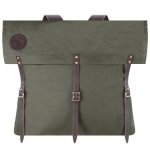
On edit: I should add that if I want to move my Duluth Pack around in camp when it is unbuckled with the overflap open, I often lift the pack by the compression flap-ears.
Perhaps what Patrick is calling compression straps are not typically called ears. And, no, they aren't meant to hang outside the pack. They are meant to be lashed together, if necessary, to keep stuff from falling out of the pack when you have other items, like a tent, stuffed on top of those compression flaps but under the big "overflap" (not sure of the technical name for that either).
The corners of the buckled down overflap are called "ears" by some people, and you can lift the entire pack out of the canoe using these two ears, functioning like handles, instead of trying to lift by the leather back straps or single top strap (if there is one of those).
The top left and right corners of the overflap in this picture are what some call ears, perhaps because they project sideways out from the body of the pack when it is full:

On edit: I should add that if I want to move my Duluth Pack around in camp when it is unbuckled with the overflap open, I often lift the pack by the compression flap-ears.
That old pack looks great. Love the green waxed cotton.
I would caution anyone that is lifting a pack by the flap not to put too much weight on the leather flap strap and buckle as it's not made to hold weight.
I just want to add that I did not make up the ear thing, or my using them to lift the packs. I don't trip with anyone that uses canvas packs and I've been doing it since before Utube videos so I must have read it. Most of the canoe writers I have read were Canadian or from Maine so it is possible they don;t do that in the Boundry Waters. As far as Mr. Birch never seeing it done in all of the hundreds of packs he has seen on the trail and the thousands of pictures he has seen he must have overlooked it in my many posts that show the ears out of the pack. Yes they will help to keep rain out and could help keep things from falling out, and I've done it a few times. But when they are tied together it prevents me from slipping things in and out of the pack (like water bottle, extra layer or rain gear) without having to undue the buckles. An easy experiment will tell if it's easier to lift the packs by the straps or the ears, especially out of the boat, you be the judge.
I just want to add that I did not make up the ear thing, or my using them to lift the packs. I don't trip with anyone that uses canvas packs and I've been doing it since before Utube videos so I must have read it. Most of the canoe writers I have read were Canadian or from Maine so it is possible they don;t do that in the Boundry Waters. As far as Mr. Birch never seeing it done in all of the hundreds of packs he has seen on the trail and the thousands of pictures he has seen he must have overlooked it in my many posts that show the ears out of the pack. Yes they will help to keep rain out and could help keep things from falling out, and I've done it a few times. But when they are tied together it prevents me from slipping things in and out of the pack (like water bottle, extra layer or rain gear) without having to undue the buckles. An easy experiment will tell if it's easier to lift the packs by the straps or the ears, especially out of the boat, you be the judge.
I have some from around 1980. Keep Lexol on the leather or it cracks and breaks.
This summer I flew to Spokane to pick up a new truck at Dave Smith the largest Dodge dealer in the world in Kellogg, ID.
I used a Duluth pack to carry my camping equipment on the plane for the camping trip across Washington from Idaho.
This summer I flew to Spokane to pick up a new truck at Dave Smith the largest Dodge dealer in the world in Kellogg, ID.
I used a Duluth pack to carry my camping equipment on the plane for the camping trip across Washington from Idaho.
If you watch Bill Mason's "Song of the Paddle" you can see that his ears are out of his pack. Maybe he mentioned it in one of his books.
Woods Packs. The other canoe pack.
I love my 2 Woods box style packs. They're the'52 GMC pickups of the canoe pack world (imo). I tried the envelope style and didn't like the slimness. Looks roomy until you start loading it. 1973 Ford Pinto? lol. Anyway...
It never occurred to me to leave the side flaps out to use them as "handles". I'd always just assumed they along with the single top flap provided a 4-folded security for the top opening = double the closure so to speak. What happens in the pack stays in the pack.
It's always bothered me not having handy grab handles on my gear. That is one feature that makes canoe life so much easier. I wince anytime I see shoulder straps handled this way, although they ought to be extra strong to withstand normal pack weight. As it is I find it easy enough to grab a handful of pack and move them just so. I expect them to see another generation of trippers.
Looking forward to Patrick's project. I know I'm gonna envy the results.
It never occurred to me to leave the side flaps out to use them as "handles". I'd always just assumed they along with the single top flap provided a 4-folded security for the top opening = double the closure so to speak. What happens in the pack stays in the pack.
It's always bothered me not having handy grab handles on my gear. That is one feature that makes canoe life so much easier. I wince anytime I see shoulder straps handled this way, although they ought to be extra strong to withstand normal pack weight. As it is I find it easy enough to grab a handful of pack and move them just so. I expect them to see another generation of trippers.
Looking forward to Patrick's project. I know I'm gonna envy the results.
Here's an update:
Found this good condition cast off boat cover for free; canvas with some sort of repellency treatment, and some leather culled from a hoard of off cuts my brother had. The canvas is gray (or is it grey?). The lighter leather will be for straps- nothing for shoulder straps yet- and the dark leather for reinforcement patches in the interior where buckles and straps connect. That leather should be easily sewable as it's quite flexible.
I discovered that waxed canvas by the yard, with shipping added, will cost about 160.00 US dollars! Egad, what's a COB to do but use what he already has! What do you think of the color? Maybe with a little portage mud and dragging it around a campsite it'll turn more brown!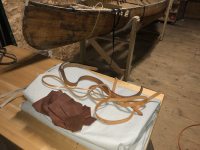
Found this good condition cast off boat cover for free; canvas with some sort of repellency treatment, and some leather culled from a hoard of off cuts my brother had. The canvas is gray (or is it grey?). The lighter leather will be for straps- nothing for shoulder straps yet- and the dark leather for reinforcement patches in the interior where buckles and straps connect. That leather should be easily sewable as it's quite flexible.
I discovered that waxed canvas by the yard, with shipping added, will cost about 160.00 US dollars! Egad, what's a COB to do but use what he already has! What do you think of the color? Maybe with a little portage mud and dragging it around a campsite it'll turn more brown!

That looks like 10 oz pearl grey sunforger canvas. Good stuff, I’ve made quite a few things from that fabric. Might be a little light duty for a Duluth pack, but give it a try.
Jim
Jim
All this pack talk got me going. I’m upgrading the “fire bag” and decided to go all in with a new bag as well. After scrolling thru a zillion “vintage boy scout packs” on ebay; i bought this one for $39.00!
At 18x18 it’s a touch bigger than what i need for fire makings but i have a Vintage Swiss Optimus 99 mountaineering stove i recently bought and with a few other “like items” it should be about perfect for my meager kit. These were pretty well made bags back in the day and this one’s certainly got a lot of life left!
At 18x18 it’s a touch bigger than what i need for fire makings but i have a Vintage Swiss Optimus 99 mountaineering stove i recently bought and with a few other “like items” it should be about perfect for my meager kit. These were pretty well made bags back in the day and this one’s certainly got a lot of life left!
Attachments
Last edited:
- Joined
- May 5, 2022
- Messages
- 26
- Reaction score
- 10
As I and my wife are not real canoeists we extensively float and over nite camp several nites in series, the Current/Jack's fork/Black rivers in Missouri EVERYONE here use waterproof Dry bags , resealable buckets , and small sealable barrels . I wonder why the different styles of containers ?? Variety is the spice of life ??Duluth canvas packs are of course not waterproof. Nor is a hiking backpack. You must use a waterproof interior liner, which will also provide air pocket flotation for the pack. Most people use a tough, clear plastic liner, such as the ones Duluth itself sells, or a more expensive breathable liner such as the Granite Gear eVent liners I use.
Here is a video of how to pack a Duluth and, at the end, how close the top of a poly liner. You can also twist the top of the liner together (instead of rolling it), fold the twisted part over, and cinch the fold with very strong rubber bands or bicycle tube.
Similar threads
- Replies
- 13
- Views
- 2K
- Replies
- 34
- Views
- 3K
- Replies
- 19
- Views
- 7K

